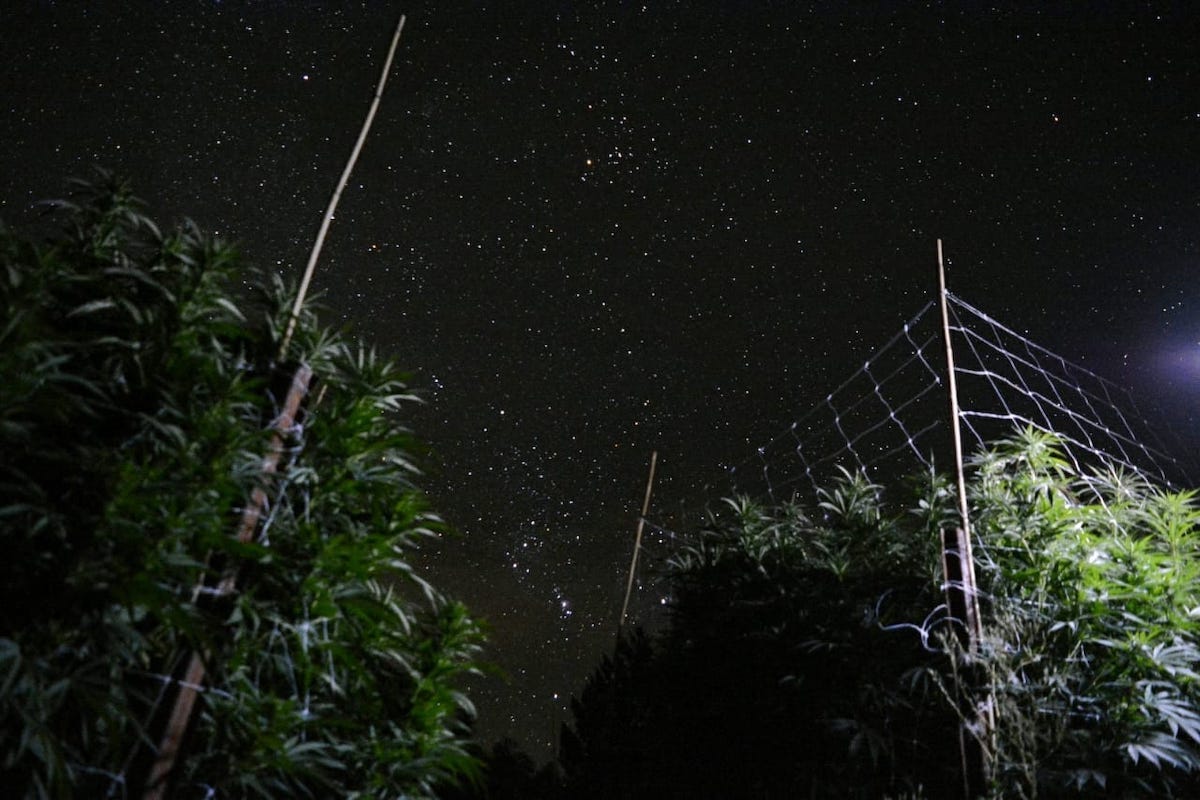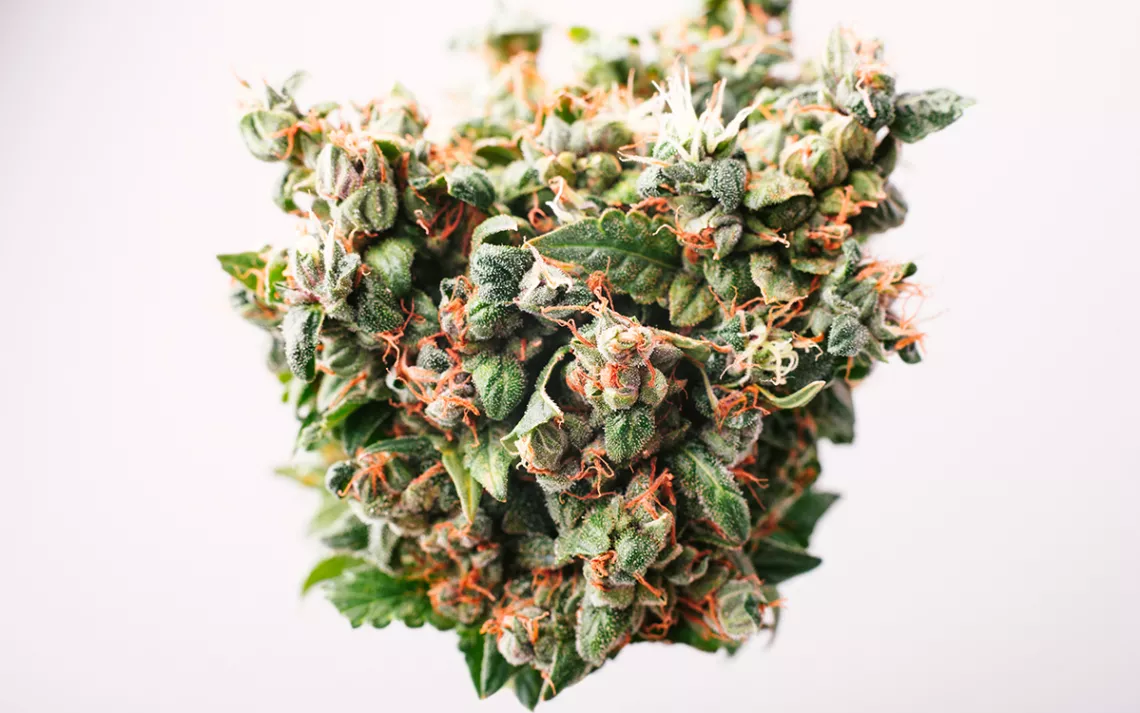A Higher Cause: Is It Possible to Consume Organic Cannabis?
Sorry, stoners, it’s . . . complicated
Thanks to its leafy branding and hippie endorsement, cannabis has long enjoyed an earthy, au naturel image. The vast majority of weed sold, however, isn’t grown in any sort of sun-dappled Eden. With global sales expected to hit $16.9 billion in 2019, cannabis has become a massive industry, much of which relies on indoor, energy-intensive growing; heavy doses of pesticides, fertilizers, herbicides, and rodenticides; and often, drug cartels. The dire effects of cannabis cultivation on waterways, forest soils, and human rights have been well documented, meaning Whole Foods acolytes should be hip to the fact that your average puff of pot isn’t clean, green, or remotely organic.
That’s because the word “organic” is essentially owned by the federal government—and while two-thirds of US states now have some form of legalization on the books, the feds still consider cannabis a Schedule 1 narcotic, meaning it’s ineligible for official USDA organic certification. (Thanks to the legalization of industrial hemp in last year’s farm bill, however, a small number of growers of cannabis’s nonpsychotropic cousin have earned the USDA seal; meaning yes, your CBD oil might actually be organic.)
“Consumers already look at marijuana as a more ‘natural’ product so don’t pay as much attention to growing methods as they might at the grocery store,” says Anthony Franciosi, head grower at Colorado’s Honest Marijuana Company. “That thinking is dangerous, because it’s more important to make sure the things you smoke are organic than the things you eat.”
While research into agricultural chemicals and cannabis is hampered by federal restrictions, scientists do know that when you eat something, your liver can help filter out toxins. When you smoke, however, the chemicals hit your bloodstream immediately. Medical patients, in particular, would be wise to find out whether their buds are laced with pesticides.
Luckily, there’s plenty of clean weed out there; more widespread legalization, after all, means more environmental regulation, control, and transparency. However, the legal cannabis market looks a lot like the Wild West right now due to the lack of cohesion between state-level laws and the hazy monitoring of greenwashing. That means today’s conscientious cannabis consumers are left to do their own due diligence. Here’s what that looks like.
For starters, learn your state’s cultivation requirements. In California, which legalized recreational cannabis in 2018 after a 20-year experiment with quasi-legal medicinal bud, farmers must be compliant with the state’s Department of Fish and Wildlife and Water Board regulations. According to Andrew DeAngelo, cofounder of the Bay Area’s Harborside dispensary, California’s lab-testing requirements are so stringent that legal weed is “pretty much organic” by the time it hits retail shelves. But don’t exhale a cloud of relief just yet. DeAngelo adds that 80 percent of California’s weed products are still illicit, meaning they come from black-market growers, dealers, dispensaries, delivery services, and online platforms. “When we’ve taken cannabis from the illicit market and sent it to the lab, results have come back dirty,” he cautions.
Karli Warner, cofounder of Garden Society, a Sonoma County growing operation that embraces biodynamic growing principles, says, “We’re required to test stringently for pesticides and heavy metals.” Her advice? Buy bud through licensed dispensaries, which in California means those listed through the Bureau of Cannabis Control. (In most parts of the state, local ordinances require dispensaries to display their BCC certification.)
Prefer the comfort of a label? Good news—the cannabis industry is almost as inundated with third-party seals and certifications as the “natural” foods market. Most are small potatoes at this point—there’s Certified Kind, which claims to be on par with USDA organic standards, and Dragonfly Earth Medicine, which focuses on more sustainable, closed-loop farming practices. The nonprofit Cannabis Certification Council is also working on a program to dole out unofficial organic certification. And multiple certifications exist to show that bud is grown outdoors, meaning minimal electricity went into your end buzz.
The oldest and most widely recognized third-party label is Clean Green Certification, which started in California in 2010 and has since expanded to certify cannabis producers in Washington, Oregon, Nevada, Colorado, Montana, and Canada. Clean Green certification—which requires annual fees and audits—is based on USDA organic standards regarding pesticides and fungicides, with additional requirements around participation in an operational carbon-footprint-reduction program, water conservation, and labor rights (farm workers must have sanitary conditions, fresh foods, and earnings of at least $15 per hour).
“As the cannabis industry moves out of the darkness and into the light, it has the potential to be an agricultural leader when it comes to clean growing, and to converting to water-saving farming techniques,” says Clean Green founder Chris Van Hook, a medical cannabis compliance attorney in California and former USDA organics inspector who says above-board farmers of notoriously thirsty cannabis plants are increasingly turning to drip irrigation, misters (rather than hose-watering), and special grow pots that reduce plants’ evaporative water loss. “Water usage in the California cannabis industry has halved since 2011,” Van Hook reports.
It’s worth noting that you can legally smoke biodynamic bud. While not a federal designation, USDA organic is the baseline for independent certification from Demeter USA, which is named for the Greek goddess of agriculture and serves to reward farms that operate as “holistic organisms” ensuring maximal biodiversity, ecosystem preservation, soil fertility, and ethical animal husbandry.
Sonoma County’s SPARC Farm is one of around 40 certified farms that grow cannabis with a cover crop (because monocultures are antithetical to biodynamic principles, you can’t get biodynamic certification if you only grow cannabis). And according to SPARC CEO Erich Pearson, conscious farmers are increasingly embracing “beyond organic” certification. “Organic has been watered down by big corporations to not mean what it used to mean,” he says, pointing to the organic agriculture community’s debate around hydroponics.
Still, many cannabis growers are vying for the coveted official organic label. In Canada, which last October became the first major nation to legalize recreational marijuana, the government is devising uniform organic standards for cannabis that follow those for food. Juli Crockett, director of compliance for MMLG, a consultancy that serves to help cannabis-related businesses navigate licensing and compliance, says California’s Department of Food and Agriculture has been tasked with creating a state-wide organic cannabis program by 2021, and that Washington and Oregon are doing the same. “There’s real industry desire for official certification, starting with cultivators’ supply chain, because many brands are proud of the way they make things and want to incorporate that in their messaging, but because of prohibitions against using the term ‘organic’ or even anything cute like ‘organix,’ don’t even play.” Crockett adds that because of the cannabis industry’s present “organic” moratorium, there’s fear and confusion around the listing of ingredients in edibles and capsules too. “Some people who source organic and fair trade ingredients are reticent to put it on labels for fear of running afoul of federal law.”
Crockett says one environmental casualty of the cannabis industry’s present “educational period” involves packaging. “In this move to protect public safety, we have all these regulations and labeling disclosure rules and we have to put a ton of packaging around products—this stuff won’t biodegrade for a number of years,” she says. “Hopefully we’ll move through all this new terrain of stigma and concerns around children’s and pet’s consumption quickly,” says Crockett, who’s optimistic that solutions are in sight, especially in places like California, where plastic straws and bags are being outlawed.
Harborside’s DeAngelo is also forward-thinking when it comes to packaging. “Cannabis is gonna lead the way out of this mess and into 100 percent hemp packaging,” he says. “What better thing to put cannabis in than cannabis?” DeAngelo also predicts that the day will come when cannabis shoppers will be able to scan a barcode with a smartphone to pull up lab results for that particular strain.
Others, like sustainability-advisor-to-the-cannabis-industry Mitchell Colbert, describe the future for green-minded weed enthusiasts as “bleak.” He argues, “The market is shifting away from environmentally friendly smoked bud to so-called vape pens—e-cigarettes imported from China, then filled with cannabis oil rather than nicotine juice.” While cannabis flowers can be dry-farmed, sun-grown, and produced with minimal additives, vaporizers’ manufactured cartridges rely on heavy metals, and their lithium-ion batteries use rare-earth metals. “What’s worse is few if any options exist for the recycling of vape devices,” says Colbert, who’s presently working with waste management companies in California and Colorado to devise vape recycling programs.
Garden Society’s Warner points out that the more manufactured a product is (think edibles and tinctures), the less pure it’s going to be, and says to ask dispensaries’ patient educators (a.k.a. “budtenders”) about different brands’ values. “They’ve probably been to the farms and are good resources,” she says. “As a rule of thumb, consuming flower has the lowest impact. Tinctures and extractions require more energy to be created, produce more waste, and have higher potential of having larger concentrations of residual pesticides.”
And if you’re convinced organic lettuce tastes better, you might feel the same about bud. According to one biochemist and agrologist (who preferred not to be named in this article) working with government regulators on certified organic standards and environmental regulations with respect to cannabis production, organic cannabis contains higher levels of medicinal cannabinoids and terpenes, and offers a more balanced “wellness feel" to the cannabis experience. “Working with [British Columbia-based cannabis producer] Rubicon Organics, I have seen analytical data of their growing processes that has lead to terpene profiles that are two times that of conventional production. Organic growing concentrates flavor more optimally,” he says, adding that Canadian Scientists are presently looking into what strains perform better under organic production systems, and breeding accordingly.
On that note, Happy 4/20, and stay tuned to find out whether Blueberry Kush or Girl Scout Cookies makes for the greener, cleaner, bong-packing choice.

Photo courtesy of Garden Society
 The Magazine of The Sierra Club
The Magazine of The Sierra Club
